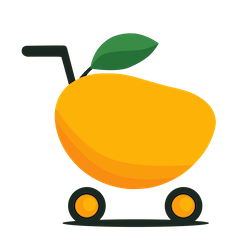For the 5-day lead magnet email sequence, jump to this section.
–
Hook New Subscribers FAST
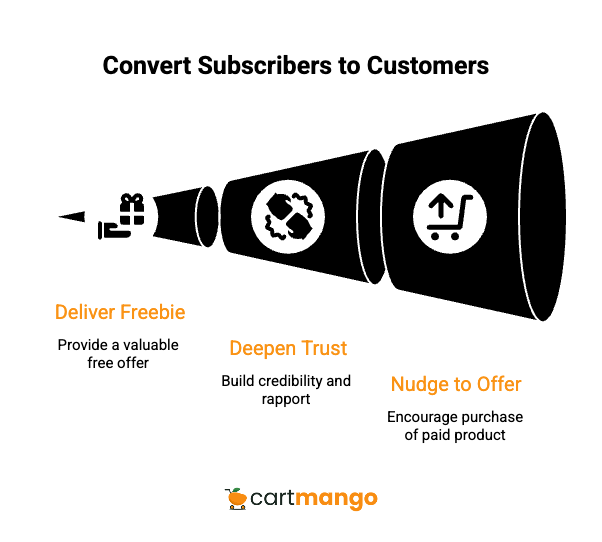
The IDEAL email sequence is an automated email series that:
- Delivers a freebie
- Deepens trust
- Smoothly nudges new subscribers toward your paid offer
Most creators make the mistakes of not doing #3 and spacing these emails days apart. That’s leaving money on the table. A lot.
New subscribers are hottest in the first 72 hours after opting in.
Think about it: they just raised their hand and said “yes, I want what you’re offering.” Their interest is peaked, their attention is yours, and their inbox is expecting you.
You’ve heard email marketing returns $36 for every $1 invested, on average (Source: Email Tool Tester).
But that number is for “average marketers” who don’t know what they’re doing.
But You? With this guide, you’ll get even higher returns.
Why Daily Emails
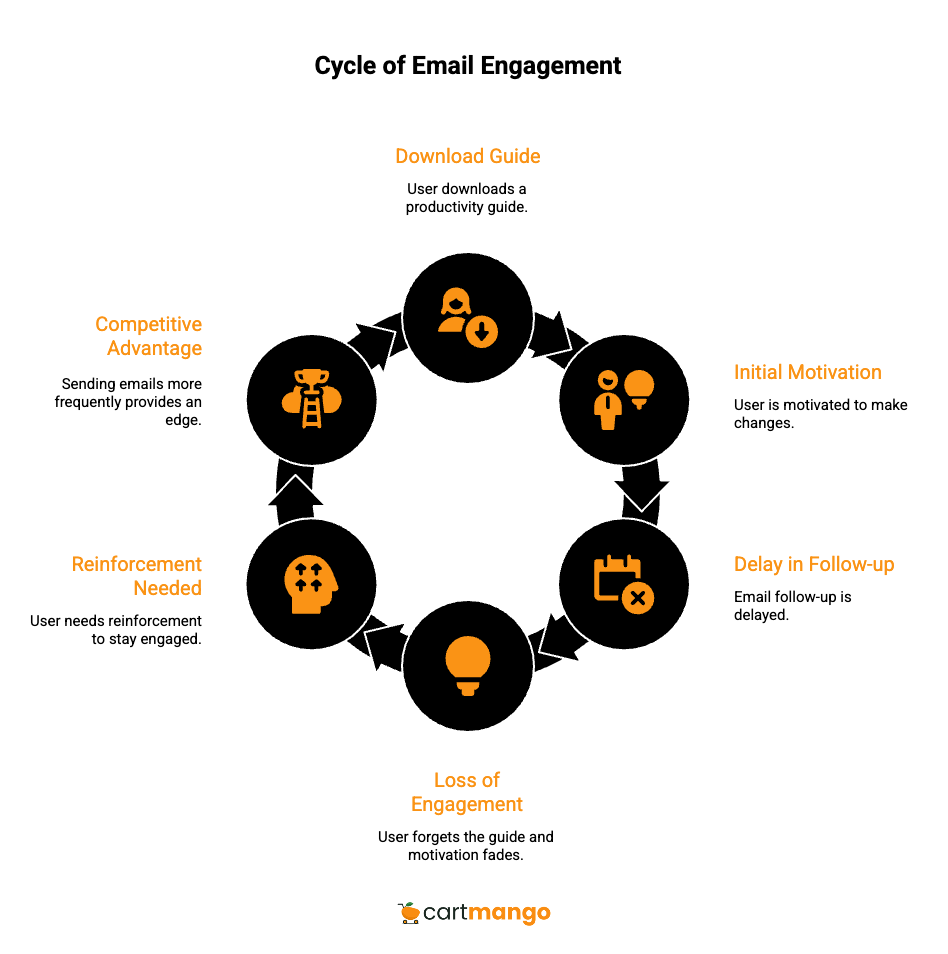
Someone downloads your productivity guide on a Tuesday morning. They’re motivated, ready to make changes.
But you only send a follow-up email on Friday. By then, they’ve forgotten your name and your freebie is buried in their downloads folder.
The psychological “honeymoon” window closes fast. Brain science tells us that new information starts fading within hours if it’s not reinforced. Your competitors are following outdated advice about sending emails every 2-3 days. That gives you a clear advantage.
79% of leads never buy without proper nurturing (Source: MarketingSherpa). The companies winning today understand that nurturing means staying top-of-mind when interest is highest, not when it’s convenient for your calendar.
Daily contact during days 1-5 accomplishes three things:
- Builds trust through consistent value delivery
- Keeps your offer fresh in their mind
- Creates anticipation for your next message
Targeted campaigns earn 14% higher open rates than generic broadcasts (Source: Mailchimp). When you combine daily frequency with value-first content, the results compound.
The Funnel That Converts
Here’s how your lead magnet email sequence fits into the bigger picture:
Moment | Subscriber Thought | Your Action |
|---|---|---|
Opt-in (Day 0) | “Looks useful!” | Deliver the magnet instantly & set expectation of five daily tips |
Days 1–5 | “Teach me more.” | Daily Story → Value → Soft-Sell emails pointing to one main offer |
After Day 5 | “What’s next?” | Move them to your weekly newsletter for long-term nurture |
Most email sequences stop after the initial delivery. That’s like opening a conversation and walking away. The real relationship building happens in days 1-5, when subscribers are deciding whether you’re worth following.
The hand-off to your weekly newsletter is crucial. You’ve spent five days proving your value. Now you transition them into your long-term content where the real relationship building continues. Subscribers who complete a nurture sequence are more likely to stay engaged with regular newsletters.
Without this transition, subscribers feel abandoned. They wonder where you went and why the helpful emails stopped coming. That’s lost trust you can’t get back.
Sell Without Selling: The SVS Formula
Every email in your sequence needs structure. But it can’t feel robotic. I use a 3-part formula that builds connection while moving people toward your offer.
Here’s the framework that’s working for me and my clients:
Segment | Target Length | What to Include | Quick Prompt Starters | Seamless Transition Example | Reader Benefit |
|---|---|---|---|---|---|
Story | ~100 words | Relatable moment & concrete “before” snapshot | “Remember the morning I ___?” | “That’s when one tiny tweak changed everything ↴” | Mirrors pain; builds rapport |
Value | ~160 words | One actionable step or mini-checklist | “Try this 3-step checklist: ___” | “…and if this quick win resonates, the deep-dive lives inside ___ ↴” | Instant win; proves expertise |
Soft Sell | ~40 words | Calm invite to the single main offer; low-friction next step | “Want the full workflow?” / “Reply help for personal guidance.” | — | Nudge without pressure |
Keep each email around 300 words total for optimal engagement and value delivery. Emails with clear value propositions and proper length outperform both overly short and excessively long content.
- The story hook creates instant connection.
- People buy from people they trust, and trust starts with shared experience.
- Your value section delivers useful info/tips.
- The soft sell feels natural because it’s positioned as additional help, not a hard pitch.
I’ve been using this formula for a few years now. The response rate is night and day compared to my old approach of cramming everything into one long email. Sometimes I catch myself wanting to add more value, but I resist. One good tip per email builds more trust than three mediocre ones.
Your 5-Day Lead Magnet Email Sequence Blueprint
Here’s how I’d write these emails for someone selling a productivity course to content creators:
Day | Story Hook → Value Tip → Soft-Sell Bridge |
|---|---|
1/ Instant Access + Win | Freebie delivery instructions → “Why this 10-min reset saved my launch” → 3-item focus checklist → “Module 1 walks you through this step-by-step.” |
2/ Roadblock Reveal | “How Maria lost 6 hrs in the edit rabbit hole” → 25-min Pomodoro template → “Ready-made template sits in Module 2.” |
3/ Case-Study Cliff-hanger | “Jen 5×-ed content with batching” → 2-hour batching worksheet outline → “Reply help and I’ll show you Jen’s workflow.” |
4/ Myth Busting | “The multitask lie that cost me a day” → Single-task timer tactic → “Lesson 4 dives deeper when you’re ready.” |
5/ Future Pace | “Picture clocking off at 4 p.m.” → 3-day sprint schedule → “Doors are always open for the full Creator Flow system.” |
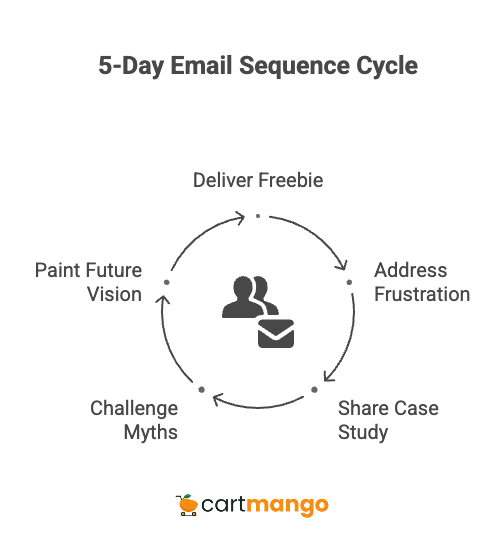
Notice how every single email points to the same main offer. That’s intentional. Subscribers get confused when you pitch different products each day. They start wondering what you actually specialize in.
Day 1 delivers the promised freebie with clear access instructions, then gives them an immediate win they can implement today. The poll creates engagement and gives you data about their biggest challenges.
Day 2 addresses a common frustration. Techsmith has great tutorials on creating quick demo videos that show rather than tell. Visual proof beats written explanation every time.
Day 3 introduces social proof through a mini case study. But here’s the key: you invite them to reply with “help” or another keyword instead of clicking a link. This starts a real conversation. No scheduling friction, no complicated booking process. Just hit reply.
Day 4 tackles a myth or misconception in your field. People love having their assumptions challenged when you provide a better way.
Day 5 paints a picture of their life after implementing your system. You’re not creating false urgency or fake scarcity. You’re simply reminding them that the option exists when they’re ready.
–
Now let’s actually write out these emails.
Day 1: Instant Access + Win
Subject: Access Creator Productivity Guide here
[Link to freebie]Access your Creator Productivity Guide here.[/Link]
Last Tuesday I had 3 meetings, 47 Slack messages, and 2 fires to put out before lunch. My creativity felt completely drained, and I had 3 more hours of work ahead of me.
Sound familiar? Most creators hit this wall daily, usually between 2-4 p.m. Your brain isn’t broken, it’s just overwhelmed by context switching and decision fatigue.
Here’s the 3-step energy reset that saved my afternoon:
Step 1: Stand up and take 10 deep breaths.
Not shallow chest breathing, but deep belly breaths that actually reach your diaphragm. Count to 4 on the inhale, hold for 4, exhale for 6. This activates your parasympathetic nervous system and reduces cortisol.
Step 2: Drink a full glass of water.
Dehydration is one of the biggest creativity killers, but we rarely notice it until we’re already foggy. Room temperature water works best, your body doesn’t have to work to warm it up.
Step 3: Write down the one thing that would make today a win.
Not five things, not your entire to-do list. One specific outcome that would make you feel accomplished when you shut your laptop.
Takes exactly 10 minutes. Costs nothing. Works every time.
[Link to paid offer] Module 1 in Creator Flow walks through 12 more resets like this, plus the science behind why they work when caffeine stops helping.[/Link]
No rush. Get it when you’re ready to up your productivity.
[Your name]
–
Day 2: Roadblock Reveal
Subject: 6 hours
My student Maria spent 6 hours editing a 4-minute Instagram reel last week.
Six hours.
She got lost tweaking transitions, adjusting colors that nobody would notice, and adding effects that made the video worse, not better.
When she finally posted it, the engagement was average. All those extra hours didn’t translate to more views, comments, or followers. She’d fallen into the perfectionism trap that kills creativity and momentum.
Here’s the 25-minute Pomodoro template that fixes this problem:
Set a timer for exactly 25 minutes.
Use your phone, computer, or a physical timer. Make it loud enough that you can’t ignore it when it goes off.
Edit with whatever comes naturally.
Cut out the obvious mistakes, add basic transitions, adjust audio levels if needed. Don’t overthink it. Your first instinct is usually right.
When the timer goes off, export the video immediately.
No exceptions, no “just one more tweak,” no second-guessing. Hit export and walk away.
This approach forces you to focus on the core edits that actually matter to viewers. Smooth transitions matter more than perfect color grading. Clear audio matter more than fancy effects. Good pacing matters more than artistic shots.
Maria tried this method for a week. Her posting frequency doubled, her stress dropped, and her engagement actually improved because she was putting out more content consistently.
[Link to paid offer] The template pack inside Creator Flow includes timing guides for different content types. Short-form videos, long-form tutorials, podcast episodes, and social media posts.[/Link]
[Your name]
–
Day 3:Case-Study Cliff-hanger
Subject: 5 videos/month to 5/week
Jen went from posting 5 videos per month to 5 per week using my 2-hour batching method.
She was burning out trying to create, edit, and post content every single day. The constant context switching was exhausting her creativity.
Now she films all her content in one afternoon, then schedules it out. Her stress dropped, her quality improved, and she actually has evenings free again.
Here’s the basic workflow that changed everything for her:
1/ Pick 5 topics during your planning session.
Don’t wing it. Sit down with your content calendar and choose topics that serve your audience and connect to your offers. Write one-sentence descriptions for each.
2/ Write simple outlines, not full scripts.
Bullet points work better than paragraphs. Include your hook, main points, and call-to-action. Keep it loose enough to sound conversational when filming.
3/ Film all 5 videos back-to-back.
Set up your equipment once, get in the zone, and knock them all out. Batch the creative energy instead of starting from scratch five different times.
4/ Edit in batch the next day.
Your editing brain is different from your creative brain. Separate the tasks for better results. Use the same settings, filters, and templates across all videos for consistency.
5/ Schedule everything at once.
Upload to your scheduler and set the publishing times. Then forget about content creation for the rest of the week.
Jen’s engagement increased 20% after implementing this system because her content became more consistent and strategic.
Reply with “workflow” and I’ll show you Jen’s exact workflow, including her topic brainstorming method and batch editing checklist.
[Your name]
–
Day 4: Myth Busting
Subject: The #1 myth (not what you think)
I tried working with dual monitors for a month.
Email on one screen, video editing on the other. I thought I was being efficient, getting two things done at once.
The result? Everything took twice as long and the quality suffered on both fronts.
My emails were short and unhelpful because half my attention was on the video timeline. My editing was sloppy because I kept getting distracted by new messages. I was busy but not productive.
Multitasking is a lie your brain tells you.
What feels like doing two things simultaneously is actually rapid task-switching, and every switch costs you focus and energy.
Here’s the single-task timer method that fixed my productivity:
Choose one screen, one task, 90-minute blocks.
Put away the second monitor. Close all browser tabs except what you need for the current task. Turn off notifications completely.
Set a 90-minute timer.
This aligns with your natural ultradian rhythms, the cycles your brain goes through every 90-120 minutes. You’ll get more deep work done in one focused block than three scattered hours.
Take a real break when the timer goes off.
Stand up, walk around, get some water. Don’t check email or social media. Let your brain actually rest for 15-20 minutes before starting the next block.
Batch similar tasks together.
Do all your email responses in one block, all your editing in another, all your writing in a third. Context switching between similar tasks is less costly than jumping between completely different activities.
The first week felt strange. I kept reaching for my phone or wanting to check “just one quick thing.” But by week two, my focus improved dramatically. Projects that used to take all day were finishing in 3-4 hours.
[Link to paid offer] Lesson 4 in Creator Flow covers the exact timer settings I use, plus strategies for handling interruptions and building better focus habits.[/Link]
Click the link above to check it out (only if you want).
[Your name]
–
Day 5: Future Pace
Subject: Don’t do this
Imagine it’s 4 pm on a Wednesday.
- Your content is scheduled through next week.
- Your inbox has three messages instead of 73.
- You’re shutting your laptop and going for a walk, knowing everything important is handled.
This isn’t fantasy. It’s what happens when you build systems instead of fighting fires every day.
Most creators live in reactive mode.
They wake up, check what’s urgent, and spend the day putting out fires. They create content when inspiration strikes, post when they remember, and respond to messages as they come in.
The result? They’re always behind, always stressed, and never building momentum toward bigger goals.
Here’s a 3-day sprint schedule that breaks this cycle:
Day 1: Content planning and strategy.
Review your goals, analyze what’s working, brainstorm new topics. No creating, just thinking and planning. This is your CEO time where you work on the business instead of in it.
Day 2: Batch creation.
Film, write, or record everything you planned yesterday. Get into creation mode and stay there. No editing, no posting, no checking analytics. Just pure creative output.
Day 3: Production and distribution.
Edit your content, write captions, schedule posts, respond to comments and messages. This is your production day where you package and distribute what you created yesterday.
Repeat this cycle every week. Three focused days instead of seven scattered ones.
The magic happens when you separate planning, creating, and producing. Each requires different energy and mindset. When you try to do all three simultaneously, you dilute your effectiveness in each area.
The full Creator Flow system walks through this step by step, with templates for each day and troubleshooting guides for common obstacles.
[Link to paid offer] Doors are always open when you’re ready to build systems that actually stick.[/Link]
[Your name]
Common Mistakes That Kill Your Sales
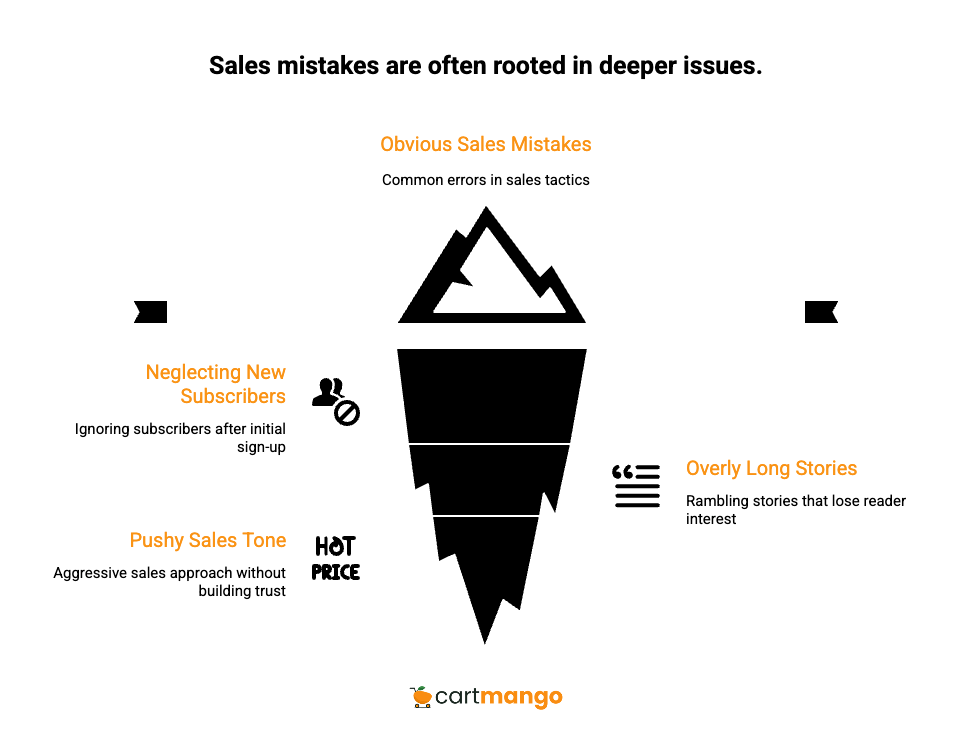
I see the same errors over and over. Here are the 3 most common ones:
Mistake | Rapid Remedy |
|---|---|
Ghosting new subscribers after opt-in and waiting for next newsletter | Launch the 5-day sequence immediately |
Story rambles past 300 words | Trim to 100-word hook; cut fluff |
Pushy “buy now!” tone | Replace with “Here’s the next step if you’d like deeper help.” |
The ghosting mistake is the worst one. You capture someone’s email when their interest is at its peak. Then you disappear for a week or a month until your next newsletter goes out. By then, they’ve forgotten who you are. They might even mark you as spam.
Stories that go on forever lose people. I get it. You want to build connection. But 100 words is enough to create relatability without boring your reader. Cut ruthlessly.
The pushy tone backfires because trust hasn’t been built yet. You’ve sent them one or two emails. They don’t know you well enough for hard sells. Soft invitations feel more natural and convert better.
Your Complete Sales Funnel Strategy
Your lead magnet email sequence is just one piece of your broader sales funnel, but it’s the piece that turns a free resource into paying potential customers. When someone downloads your promised lead magnet, they’re entering a carefully designed customer journey that should convert leads systematically.
The biggest mistake many businesses make is treating their excellent lead magnet as a standalone free offer. Your great lead magnet should connect seamlessly to your broader digital marketing strategy and lead generation efforts.
Here’s how successful business owner operators think about the complete picture:
Choose Your Lead Magnet Topic Strategically
Your niche topic needs to solve one specific problem for your target audience while naturally leading to your paid solution. A free webinar about productivity challenges should connect to your productivity course. A video series about content creation should lead to your content strategy consultation.
Map the Complete Customer Journey
- Landing page captures the lead signs up through your signup form
- Welcome sequence email delivers your promised lead magnet immediately
- Follow up email sequence (your 5-day sequence) builds additional value
- Then transitions them to regular marketing campaigns
- Each touchpoint moves them closer to the desired action
Many businesses create complex information dumps instead of focused free resources. Your lead magnet should achieve specific result for subscribers while leaving them wanting more depth.
A great example: if you’re teaching Instagram growth, your free resource might be “5 Post Types That Double Engagement” rather than “Complete Instagram Marketing Guide.” The focused approach creates better lead generation results and clearer paths to your paid offerings.
Success Story Integration
Weave customer success stories throughout your sequence. When someone sees how your free consultation helped another business owner achieve specific result, they’re more likely to take that same step. Social proof works because it shows the transformation possible when they provide additional trust to your process.
Your website and landing page should reinforce the same messaging as your email sequence. Consistency across all touchpoints helps establish trust and build credibility with new leads.
Maximizing Conversions Across Devices
Once a subscriber signed up for your free offer, your job shifts to increasing conversions through every interaction. This means optimizing for mobile devices, where the majority of emails are opened, and ensuring your sales pitch feels helpful rather than pushy.
Mobile-First Email Design
Your first email needs to work perfectly on mobile devices. Test how your promised lead magnet downloads on phones and tablets. If subscribers can’t easily access what they signed up for, you’ve created a missed opportunity that damages trust from day one.
Deliver Your Lead Magnet Seamlessly
The moment someone completes your signup form, they should receive clear instructions for accessing their free resource. Don’t make them hunt through complex information or navigate multiple pages. Direct download links work better than requiring additional logins.
Capture Leads Without Friction
Your landing page should focus on one desired action: getting email subscribers to download your lead magnet. Remove navigation menus, social media links, and other distractions. The cleaner your page, the higher your conversion rates.
Build Credibility Through Consistency
Every email in your follow up email sequence should reinforce why they made a smart choice downloading your lead magnet topic resource. Provide additional value in each message while maintaining the same helpful tone that convinced them to subscribe initially.
Additional Resources Strategy
Instead of overwhelming new leads with everything you offer, mention additional resources strategically. If someone engages with your email about productivity, you might mention your free consultation for business owners who want personalized guidance.
Your welcome email should set expectations for what’s coming next. Tell them they’ll receive 5 daily emails with practical tips, then transition to your weekly newsletter. This prevents confusion and reduces unsubscribes.
The goal isn’t just to convert leads into customers immediately. Smart digital marketing focuses on building relationships that increase conversions over time. Some subscribers will buy after the first email, others need months of nurturing before they’re ready for your sales pitch.
Track which elements of your customer journey produce the highest conversion rates, then optimize based on real data rather than assumptions.
Launch Your Lead Magnet Email Sequence This Week
Use this checklist to go from 0 to a live email sequence:
Email Setup
- Write 5 subject lines, 7 words maximum, benefit- or curiosity-first
- Schedule Day 1 to send instantly after opt-in
- Set Days 2-5 to send at the same hour each day
- No more than 300 words/email (100 story + 160 value + 40 soft sell)
- Use a simple, quick email marketing tool like BirdSend (only for creators)
Content
- Include clear download instructions in Day 1 email
- One practical tip per email, one call-to-action
- Use simple, everyday language for clarity
- Use text hyperlinks instead of buttons
- Use “reply with x” to trigger one-to-one conversations
Technical Checklist
- Verify SPF and DKIM records for your domain
- Google’s postmaster guide walks through the setup process
Your Turn
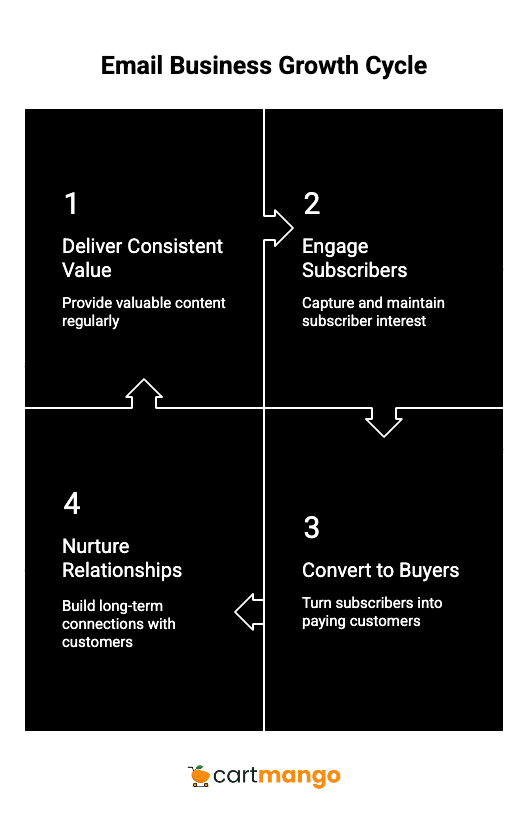
Most people overthink this process. You don’t need perfect copy or professional graphics. You need consistent value delivery and clear next steps. I’ve seen simple text emails outperform designed newsletters when the content hits the right pain points.
The difference between creators who build email lists and creators who build email businesses is follow-through. Your list is only valuable if you nurture it properly from day one.
Five value-packed emails turn curious subscribers into engaged buyers. Then they flow naturally into your weekly newsletter where the long-term relationship building continues.
Make those first 5 days count.
Related
- Sellfy vs Payhip: The Recurring Revenue Prison (2026)
- Podia vs Gumroad: The Recurring Revenue Handcuffs (2026)
- SendOwl vs Gumroad: The Recurring Revenue Black Hole (2026)
- Gumroad vs Sellfy: The Vendor Lock-in Cage (2025)
- Gumroad vs Payhip: The Hidden Trap for Creators (2025)
- ThriveCart vs SamCart – The Subscription Hostage Trap (2025)
- 8 ThriveCart Alternatives & The Lifetime Pricing Paradox (2025)
- 8 SamCart alternatives + Subscription hostage (2025)
- The GENTLE Method: Soft marketing for creators
- How Far in Advance Should You Promote a Webinar?
